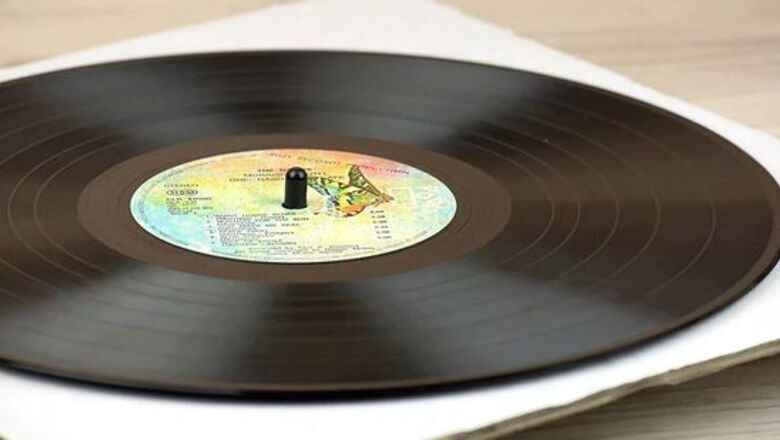
views
- Dust your vinyl record with a carbon fiber brush or microfiber cloth by gently following the record’s grooves.
- Then, clean the record with a microfiber cloth dampened in distilled water mixed with dish soap.
- Wipe the record with a microfiber cloth wet with distilled water. Then, dry it with a clean microfiber towel.
Cleaning Records By Hand
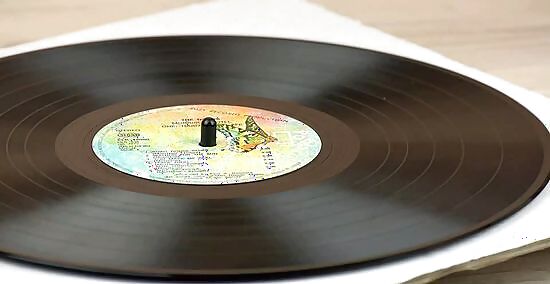
Place the vinyl on a microfiber towel or record cleaning mat. To protect your vinyl record from dirt and scratches as you clean, lay down a protective cleaning mat that can absorb liquids. Or, use a microfiber cloth.
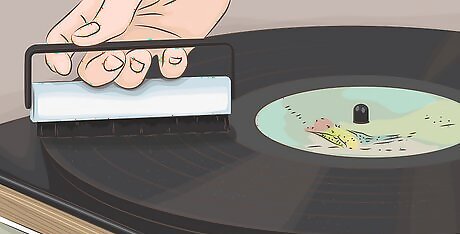
Dust along the grooves using a carbon fiber brush or microfiber cloth. Remove any dust and dirt before you clean to ensure that debris doesn’t scratch your record. Simply take a carbon fiber brush or a microfiber cloth and wipe it around the record in circular motions, following the grooves. Just start at the inner grooves and work your way toward the edge using very gentle, even pressure. After you dust one side, flip it over and dust the other.
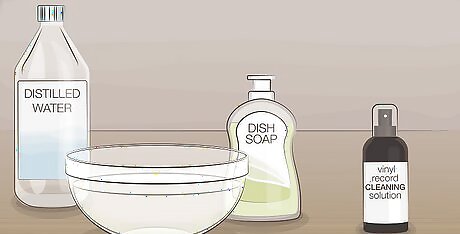
Mix distilled water with several drops of dish soap. To prevent impurities and residue from sticking to your record, use distilled water instead of regular tap water. Just fill a small bowl with distilled water and add several drops of dish soap. Then, stir the soap and water together. Alternatively, use a vinyl record cleaning solution. These either come as concentrates that you mix with distilled water or ready-to-use sprays. Make your own distilled water if you don’t already have some.
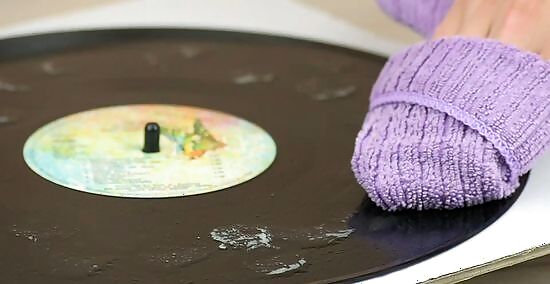
Dampen a microfiber cloth in soapy water and wipe along the grooves. Run the damp, microfiber cloth over the record by following the grooves in the vinyl. Just use a very light touch to prevent yourself from damaging or cracking the record. For moldy, mildewy records: Mix 1 part isopropyl alcohol with 3 parts distilled water in a spray bottle. Spray your record and then wipe it with a microfiber towel. Then, clean your vinyl with the dish soap. To remove dried paint: Scrape off the paint with a toothpick. Or, combine 1 part isopropyl alcohol with 3 parts distilled water in a spray bottle. Spray the paint, let it sit for 1 minute, and then wipe your record with a cloth.
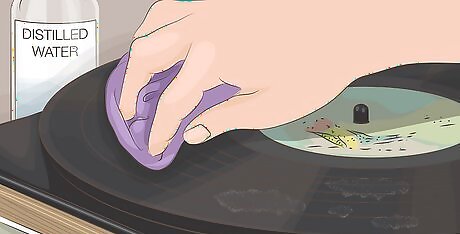
Wet a clean cloth with distilled water and wipe the record. While dish soap effectively cleans your records, it can leave behind a soapy residue. So, wet a new, microfiber cloth with distilled water and squeeze out the excess moisture. Then, wipe it around the record following the grooves. Clean the other side of the record using the same steps mentioned above.
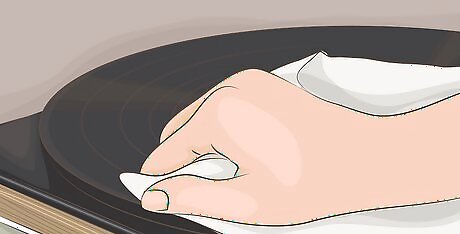
Wipe the vinyl with a dry cloth and let it air dry for 30 minutes. Use a clean, microfiber cloth to dry the record. Then, leave the record on the cleaning mat to completely dry for at least 30 minutes. Or, set it on a dish rack. Putting a wet record back in its casing can damage it and encourage mold, mildew, or other bacteria to grow.
Dusting Records
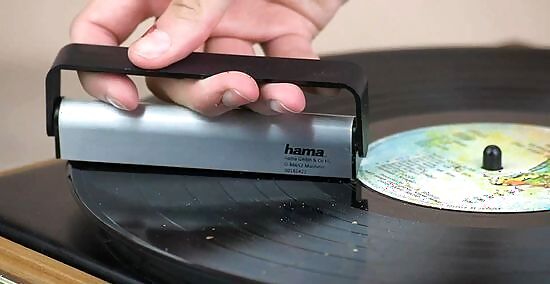
Dust your record with a carbon fiber brush. With your record on the turntable, gently press the brush onto your record. Then, spin the record with your fingers slowly, guiding the brush fibers into the grooves. Or, manually sweep the brush from the inner to outer rings of the record. Replace your brush when the fibers start to bend, fall out, or appear dirty. Dust your records before and after you play them. Clean the record needle, or stylus, before you play music, too. Simply use a stylus cleaning brush to gently brush the tip of the needle.
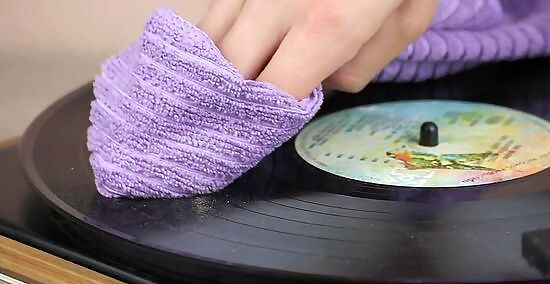
Wipe away dust with a microfiber cloth. Simply wipe the microfiber cloth around the record in a circular motion, starting at the innermost groove. Then, follow the grooves to the outside of the record.
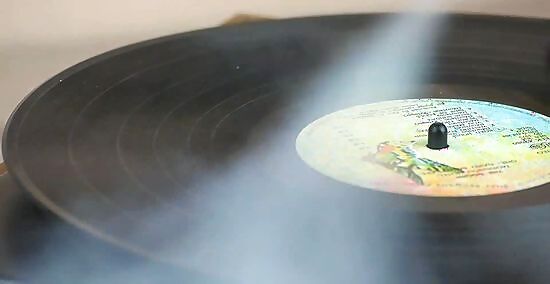
Spray away dust and debris with compressed air. Aim the compressed air can nozzle several inches above your record. Then, gently puff the air onto the record’s grooves to lift off any dust and blow it away. Canned air can sometimes release moisture. If you see any condensation on your record, wipe it dry with a clean, microfiber towel.
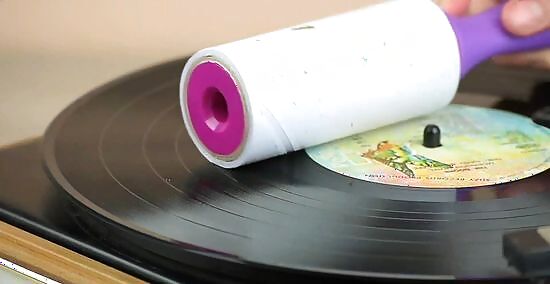
Collect dust and debris with a record roller. Record rollers have a slightly sticky surface that easily picks up dust and debris. Simply brush the roller over the record using circular motions and gentle, even pressure. Clean off any dust, dirt, or debris on the roller by rinsing it under water. Alternatively, use a lint roller.
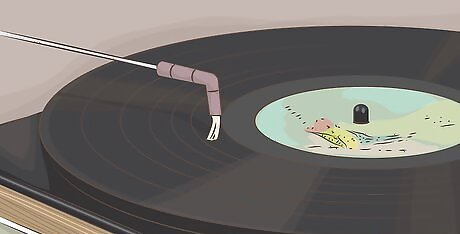
Add a record cleaning arm to remove dust as you play music. A record cleaning arm is an attachment brush that you place onto your record player. The arm sits above the vinyl and gently brushes away dust and dirt from your record as it rotates. As a bonus, it can help prevent static that attracts dust and keep your stylus dust-free as well. Most record-cleaning arms attach to the edge of your record player with adhesive.
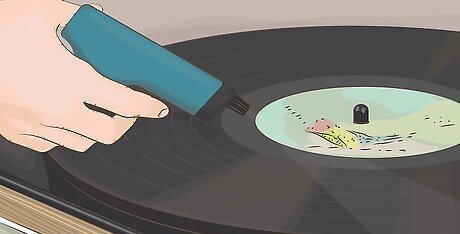
Use an anti-static gun to prevent dust from settling on your records. Anti-static guns remove static electricity from the surface of your record which can attract dust and debris. To use most anti-static guns, hold the device 12 inches (30 cm) above the record. Slowly squeeze the trigger down and then slowly release it. Just repeatedly aim, squeeze, and release the gun several times along the edges of the record. If your record makes crinkling, crackling, or crunching noise when you take it out of its sleeve, or put it in, it’s likely full of static.
Professional Cleaning Methods
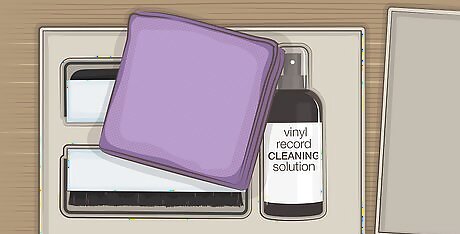
Use a record cleaning kit for a more specialized deep clean. Most record cleaning kits come with a special cleaning solution and record brushes. Simply follow the package's instructions to deep clean your record. This typically involves dusting the record with the brush and spraying it with the cleaning solution.
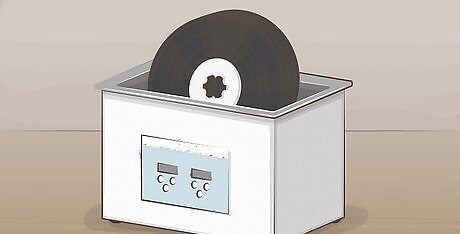
Opt for a record washing machine to clean both sides at once. A record washer is a small machine that brushes and cleans your record. To use most machines, you simply fill it with distilled water, add a few drops of cleaning solution, insert your vinyl, and rotate your record to get it sparkling clean. Most record washers come with a record cleaner.
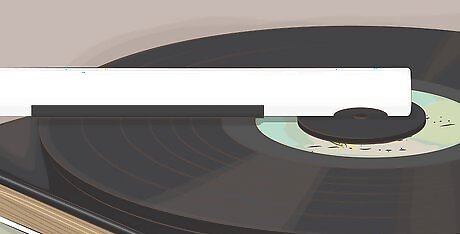
Go for a record vacuum cleaner if you’re a serious collector. One of the best ways to clean your records is to use a specially designed-vacuum. These vacuums delicately and thoroughly remove dust and debris without harming your records. Record vacuums tend to be very expensive, but they’re a great option if you have a large vinyl collection. Do not use a regular vacuum to clean your records. The powerful suction can damage or warp the vinyl.
Taking Care of Your Records
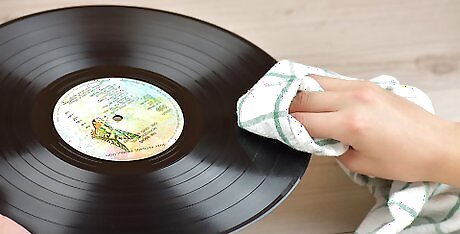
Play and store your records when they’re completely dry. Contrary to the popular myth, playing a wet record doesn’t reduce static build-up. Instead, playing a wet record can damage the grooves and create an even bigger mess. Storing them while they’re wet can also attract more dust and even cause mold to grow. Whenever you deep clean your records, wipe them with a microfiber cloth and let them completely air dry on a cleaning mat or rack.
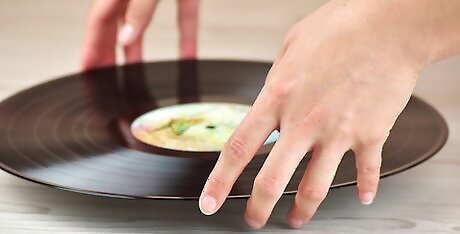
Hold records by the outer edges and record labels. Touching the surface of your record can leave dirt, dust, and oily fingerprints inside the grooves. This is what typically causes annoying pops and clicks as you listen to music. Instead, handle your records by grabbing the very outer edge with your fingertips or by holding onto the label.
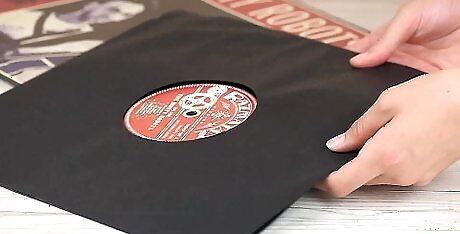
Place your records in plastic sleeves. Plastic sleeves preserve the quality of your records by removing static, blocking dust, and preventing scratches. After you clean or play your record, simply store it in an anti-static, archival-quality plastic sleeve and then place the sleeve inside the record cover. While paper sleeves are better than nothing, they can scratch your records and generate static.
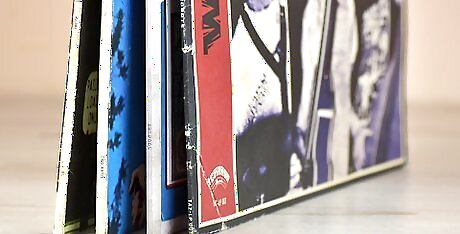
Store your records vertically with plenty of space between them. Stacking your records flat on top of each other can cause them to warp and become unplayable. So, place your records vertically and next to one another. Give each record a bit of space to breathe, as jamming too many records together can also cause them to warp. Protect your records from damage by storing them away from direct light, extreme temperatures, and humidity.




















Comments
0 comment